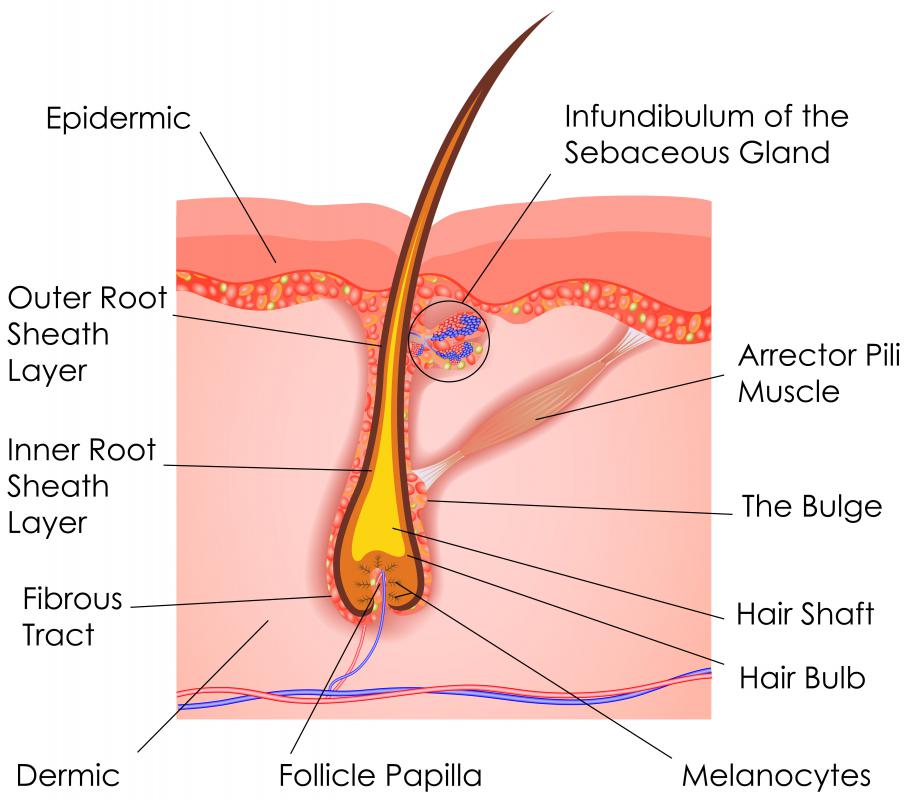At WiseGEEK, we're committed to delivering accurate, trustworthy information. Our expert-authored content is rigorously fact-checked and sourced from credible authorities. Discover how we uphold the highest standards in providing you with reliable knowledge.
What Is the Connection between Seborrheic Dermatitis and Hair Loss?
Seborrheic dermatitis and hair loss might be related to each other in some patients who suffer from this skin condition. Uncomfortable, scaly, dry patches on the scalp are a direct result of seborrheic dermatitis and can cause a person tremendous discomfort. As a result, the sufferer is tempted to scratch these places, usually where hair also is present. Constant scratching can cause hair to tear off or even prevent follicles from producing new hairs. Hair loss is often temporary and can usually be reversed with seborrheic dermatitis treatment.
Though infectious skin conditions are sometimes linked to severe hair loss, seborrheic dermatitis is not infectious in nature. It cannot be spread between people regardless of how much a person may scratch. The most common cause of seborrheic dermatitis is malassezia, an oil-producing yeast. Weather changes, as well as extreme fatigue and anxiety, can worsen preexisting seborrheic dermatitis.

Seborrheic dermatitis and hair loss are related, depending on where the patches are located. Red, oily, and yellowish scales are symptoms characterized by this type of dermatitis. The scalp is one of the most common places where the patches develop, although seborrheic dermatitis is known to develop almost anywhere on the body. This includes the area behind the ears, as well as the face and chest.

Sebum is an oily substance that is produced from the pores of the skin. It is thought that an increase in sebum production is related to malassezia, and an overall increase in oiliness of the skin. Sebum can trap hair follicles in the skin, causing the resulting scaly patches of seborrheic dermatitis, which might prevent new hair from growing.
Itchy, aggravated skin is characteristic of seborrheic dermatitis. The scales are uncomfortable, and patients scratch at the skin repeatedly. When a patient scratches the scalp or other hairy areas, the hair follicles might temporarily be destroyed. As a result, any existing hairs can break apart from their follicles causing temporary hair loss.

Young babies are especially prone to these patches. In infants, seborrheic dermatitis is called cradle cap. Oil in the skin tends to increase in infants, especially on the scalp, eyebrow area, and ears, among others. At the same time, an infant might be naturally losing hair loss within the first few weeks of life. Hair loss can be further aggravated in babies with dermatitis on the scalp. Other periods of life, such as puberty, can also lead to seborrheic dermatitis due to an increase in hormone levels.

There are a variety of ways to help prevent and treat seborrheic dermatitis and hair loss. The first step is to control oil production. If a patient is prone to seborrheic dermatitis on the scalp, he or she might want to wash his or her hair daily to control oiliness with a dandruff shampoo. Anti-fungal ointments and topical corticosteroids are other medications that a doctor might recommend for seborrheic dermatitis.

Patients might consider consistent vigilance when it comes to seborrheic dermatitis and hair loss. Hair will likely grow back once the skin condition is treated, but there is a risk that seborrheic dermatitis will return if the skin isn’t properly cared for. As a result, temporary hair loss might recur and may eventually become permanent if the cycle continues to repeat.
AS FEATURED ON:
AS FEATURED ON:















Discuss this Article
Post your comments